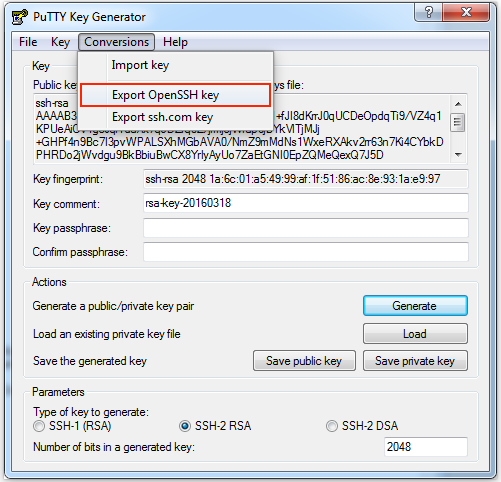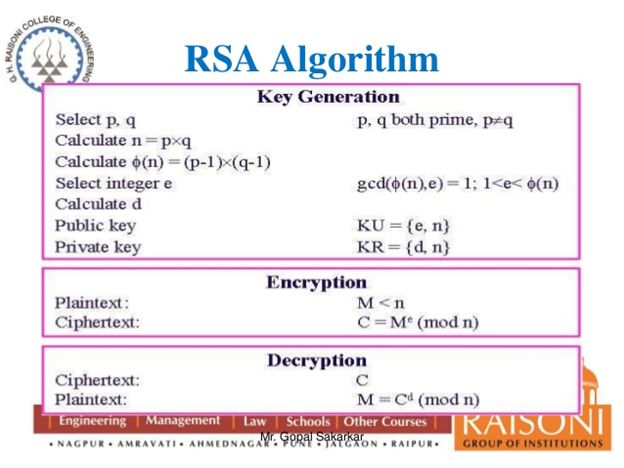Generate Private Key Windows Rsa
- Generate Private Key Windows Rsa 7
- Generate Rsa Public Key
- Generate Private Key Windows Rsa 2017
- Windows Generate Rsa Key Pair
You can also use Microsoft IIS to generate a Private Key and CSR.
How to generate a CSR in Microsoft IIS 7
Generating Public and Private Keys with openssl.exe. To perform the following actions for Windows or Linux, you must have OpenSSL installed on. Open the Command Prompt ( Start Programs Accessories Command Prompt ). Navigate to the following folder: C:Program. Jul 09, 2019 Normally, the CSR/RSA Private Key pairs on Linux-based operating systems are generated using the OpenSSL cryptographic engine, and saved as files with “.key” or “.pem” extensions on the server. But no specific extensions are mandatory for text files in Linux, so the key file may have any name and extension, or no extension at all. Generating a new SSH key. Open Terminal Terminal Git Bash the terminal. Paste the text below, substituting in your GitHub Enterprise email address. $ ssh-keygen -t rsa -b 4096 -C 'youremail@example.com' This creates a new ssh key, using the provided email as a label. Generating public/private rsa key pair.
Sep 26, 2019 To generate an SSH key with PuTTYgen, follow these steps: Open the PuTTYgen program. For Type of key to generate, select SSH-2 RSA. Click the Generate button. Move your mouse in the area below the progress bar. Type a passphrase in the Key passphrase field. Click the Save private key.
1. Click Start, then Administrative Tools, then Internet Information Services (IIS) Manager.
2. Click on the server name.
3. From the center menu, double-click the 'Server Certificates' button in the 'Security' section (it is near the bottom of the menu).
4. Next, from the 'Actions' menu (on the right), click on 'Create Certificate Request.' This will open the Request Certificate wizard.
5. In the 'Distinguished Name Properties' window, enter the information as follows:
- Common Name - The name through which the certificate will be accessed (usually the fully-qualified domain name, e.g., www.domain.com or mail.domain.com).
- Organization - The legally registered name of your organization/company.
- Organizational unit - The name of your department within the organization (frequently this entry will be listed as 'IT,' 'Web Security,' or is simply left blank).
- City/locality - The city in which your organization is located.
- State/province - The state in which your organization is located.
6. Click Next.
7. In the 'Cryptographic Service Provider Properties' window, leave both settings at their defaults (Microsoft RSA SChannel and 2048) and then click next.
8. Enter a filename for your CSR file.
9. Remember the filename that you choose and the location to which you save it. You will need to open this file as a text file and copy the entire body of it (including the Begin and End Certificate Request tags) into the online order process when prompted
2. Back Up Private Key
To backup a private key on Microsoft IIS 6.0 follow these instructions:
1. From your server, go to Start > Run and enter mmc in the text box. Click on the OK button.
2. From the Microsoft Management Console (MMC) menu bar, select Console > Add/Remove Snap-in.
3. Click on the Add button. Select Certificates from the list of snap-ins and then click on the Add button.
4. Select the Computer account option. Click on the Next button.
5. Select the Local computer (the computer this console is running on) option. Click on the Finish button.
6. Click on the Close button on the snap-in list window. Click on the OK button on the Add/Remove Snap-in window.
7. Click on Certificates from the left pane. Look for a folder called REQUEST or 'Certificate Enrollment Request> Certificates
8. Select the private key that you wish to backup. Right click on the file and choose > All Tasks > Export
9. The certificate export wizard will start, please click Next to continue. In the next window select Yes, export the private key and click Next
10. Leave the default settings selected and click Next.
11. Set a password on the private key backup file and click Next
12. Click on Browse and select a location where you want to save the private key Backup file to and then click Next to continue. By default the file will be saved with a .pfx extension.
13. Click Finish, to complete the export process
3. Convert to RSA Private Key Format
The private key is backed up as a ‘.pfx’ file, which stands for Personal Information Exchange.
To convert it to RSA Private Key format supported by inSync:
1. Download and install latest version of OpenSSL for windows from http://www.slproweb.com/products/Win32OpenSSL.html.
Note: OpenSSL requires Visual C++ 2008 Redistributables which can be downloaded from the same website.
2. Open command prompt, navigate to C:OpenSSL-Win32bin>, and run the following commands.
3. The private key will be saved as ‘myserver.key’.
4. Carefully protect the private key. Be sure to backup the private key, as there is no means to recover it, should it be lost.
To perform the following actions for Windows or Linux, you must have OpenSSL installed on your system.
Generating the Private Key -- Windows


In Windows:
1. Open the Command Prompt (Start > Programs > Accessories > Command Prompt).
2. Navigate to the following folder:
C:Program FilesListManagertclwebbincerts
3. Type the following:
openssl genrsa -out rsa.private 1024
Generate Private Key Windows Rsa 7
4. Press ENTER. The private key is generated and saved in a file named 'rsa.private' located in the same folder.
NOTE The number '1024' in the above command indicates the size of the private key. You can choose one of five sizes: 512, 758, 1024, 1536 or 2048 (these numbers represent bits). The larger sizes offer greater security, but this is offset by a penalty in CPU performance. We recommend the best practice size of 1024.
Generating the Public Key -- Windows
1. At the command prompt, type the following:
openssl rsa -in rsa.private -out rsa.public -pubout -outform PEM
2. Press ENTER. The public key is saved in a file named rsa.public located in the same folder.
Generating the Private Key -- Linux
1. Open the Terminal.
2. Navigate to the folder with the ListManager directory.
3. Type the following:
openssl genrsa -out rsa.private 1024
Generate dkim key pair. Button.Step 3: Copy the value ( t=y; o=;) from Policy field and paste it to the 'Text' text box and input ' domainkey'in Record Name. Click the OK button.This record is optional, you don't have to add it.
Generate Rsa Public Key
4. Press ENTER. The private key is generated and saved in a file named 'rsa.private' located in the same folder.
Generating the Public Key -- Linux
1. Open the Terminal.
2. Type the following:
openssl rsa -in rsa.private -out rsa.public -pubout -outform PEM
Generate Private Key Windows Rsa 2017
2. Press ENTER. The public key is saved in a file named rsa.public located in the same folder.